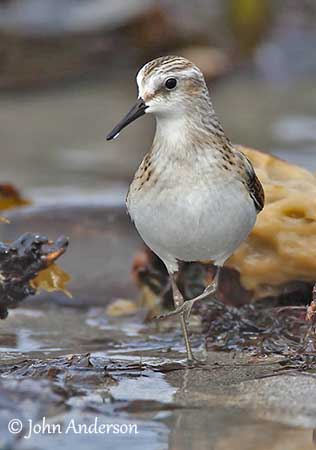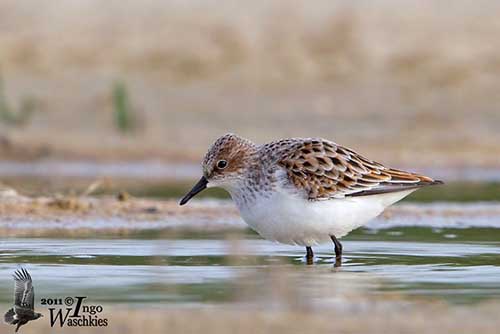
Fr: Bécasseau minute
Ang: Little Stint
All: Zwergstrandläufer
Esp: Correlimos Menudo
Ita: Gambecchio comune
Nd: Kleine Strandloper
Sd: Småsnäppa
Photographers:
John Anderson
John Anderson Photo Galleries
Paul Guillet
Photos d’Oiseaux
Otto Plantema
Trips around the world
Ingo Waschkies
Bird Photography
Text by Nicole Bouglouan
Sources:
HANDBOOK OF THE BIRDS OF THE WORLD Vol 3 by Josep del Hoyo-Andrew Elliott-Jordi Sargatal - Lynx Edicions - ISBN : 8487334202
SHOREBIRDS by Peter Hayman, John Marchant and Tony Prater – Christopher Helm – 1986 – ISBN: 0747014035
THE HANDBOOK OF BIRD IDENTIFICATION FOR EUROPE AND THE WESTERN PALEARCTIC by Mark Beaman, Steve Madge - C. Helm - ISBN: 0713639601
ENCYCLOPEDIE DES OISEAUX DE FRANCE ET D’EUROPE – de Peter Hayman et Rob Hume - Flammarion – ISBN : 2082009920
THE COMPLETE BOOK OF BRITISH BIRDS – Written by “Royal Society for the Protection of Birds” experts - Préface de Magnus Magnusson - Michael Cady- Rob Hume Editors - ISBN: 0749509112
GUIDE DES LIMICOLES de D. Taylor - Delachaux et Niestlé - ISBN : 2603014080
What Bird-The ultimate Bird Guide (Mitchell Waite)
Little Stint
Calidris minuta
Charadriiformes Order – Scolopacidae Family
INTRODUCTION:
The Little Stint is a small common wader included in the subfamily Calidrinae in the family Scolopacidae. It is the smallest sandpiper nesting in Europe, with a length of 12-14 centimetres.
It breeds in Northern Europe on the Arctic tundra, and migrates S to winter in warmer regions in Africa and India. This small wader is a long-distance migrant.

DESCRIPTION OF THE BIRD:
Biometrics:
Length: 12-14 cm
Wingspan: 28-31 cm
Weight: 20-44 g
The adult in breeding plumage has rufous upperparts. Feathers have blackish centres and pale rufous edges and tips, creating a conspicuous scaled pattern. There is a whitish V on mantle.
Head, neck and breast are rufous with dark streaks, whereas chin and throat are white, like belly and undertail-coverts. We can see a pale supercilium from lores to ear-coverts.
The female has similar plumage, but she is larger than male.
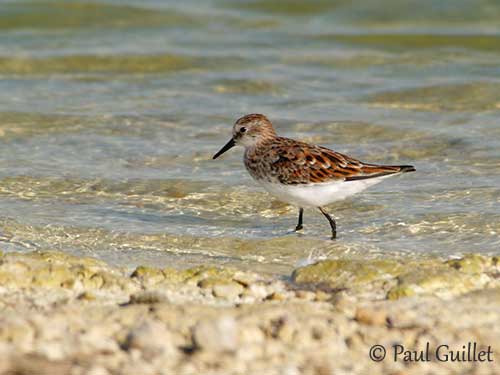
The non-breeding adult is greyer, with brownish-grey upperparts showing dark mottling and pale fringes. On the head, the crown is grey with dark streaks. Breast sides and eye stripe are dull grey. Face and underparts are white.
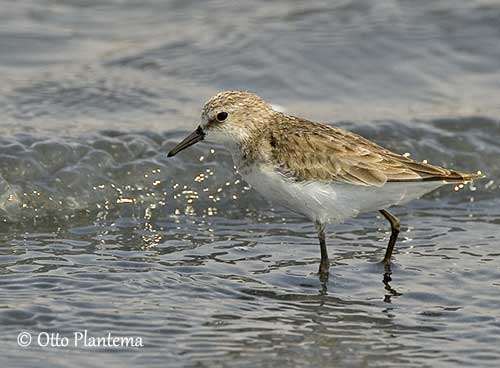
The juvenile has broad, whitish eyebrow contrasting with the dark crown. On the upperparts, we can see the white V on the mantle. Feathers are mostly blackish with rufous and white edges. Head and breast are pale buff, the crown is pale grey, neck and eye stripe ate narrowly streaked.
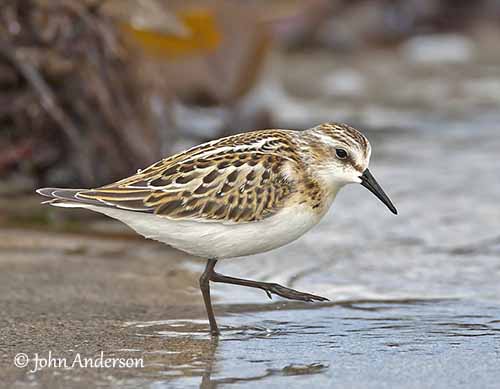
RANGE:
The Little Stint breeds in arctic regions of Europe and Asia, from N Scandinavia, through Novaya Zemlya and NW and NC Siberia to New Siberian Islands and R Yana.
It is a long-distance migrant and it winters to Africa and India, from Mediterranean regions and Africa, through Arabian Peninsula and Persian Gulf, E to Indian Subcontinent and Myanmar.
Some vagrants may occur in N America and Australia, and small numbers can be seen in SE Britain and Madagascar.
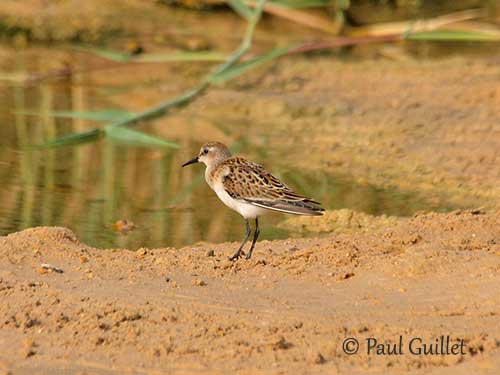
HABITAT:
The Little Stint breeds in the High Arctic Tundra on dry grounds or grassy areas, fairly close to pools and lakes, among small willows or near salt-marshes.
On migration, it can be seen at small inland waters, riverbanks, or on coastal mudflats and seashores, and at freshwater lakes on passage.
During winter, it frequents estuaries, coastal lagoons and tidal creeks.
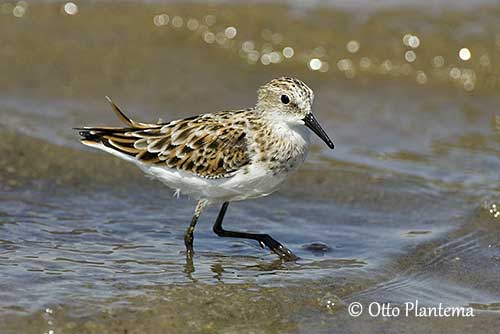
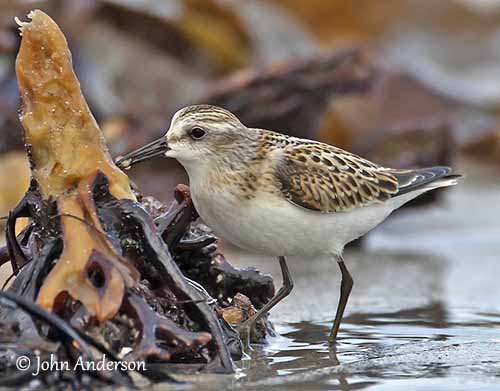
CALLS AND SONGS: SOUNDS BY XENO-CANTO
The Little Stint gives sharp, staccato “kip” or “tit” in flight, but higher and weaker than that of Sanderling. It also utters a quiet, clear “tip-tip” or “stit-stit” during the migration in groups.
During the aerial displays, it gives some “swee-swee-swee” notes, also given from the ground in breeding season.
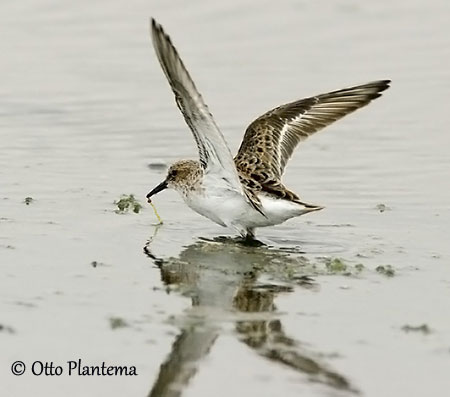
BEHAVIOUR IN THE WILD:
The Little Stint feeds primarily on invertebrates such as larvae and adults Diptera and small beetles during the breeding season. Outside this period, it also feeds on ants, Hymenoptera, water-bugs and annelids, and also takes molluscs, crustaceans and some plant matter.
It feeds by rapid pecking from mud surface. It also probes sometimes, and wades in shallow water. The preys are detected by sight. It may sometimes defend its feeding territory against other waders.
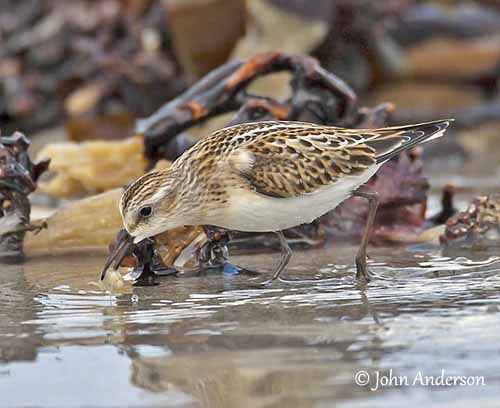
The Little Stint is gregarious and very sociable. They may form small to large flocks on passage and in winter, and also frequent mixed-species flocks. They often gather in large flocks to roost at high tide or at night during winter.
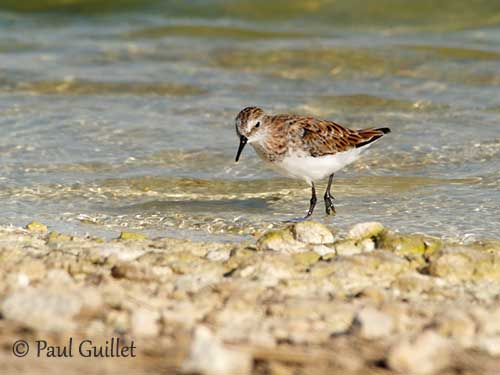
During the breeding season, the Little Stint is reported to be polygamous, but numerous birds are monogamous. The species ensures as many young as possible are raised. For that, the females often lay two clutches of 3-4 eggs, with males and females incubating separate clutches. Two complete families are reared by only one pair.
The Little Stint performs aerial displays including various flight-patterns accompanied by songs and contact calls. The bird makes exaggerated slow wingbeats with dangling legs and lowered tail. It also performs a short, vibrating flight on V-shaped wings, and a glide on arched wings below the horizontal level.
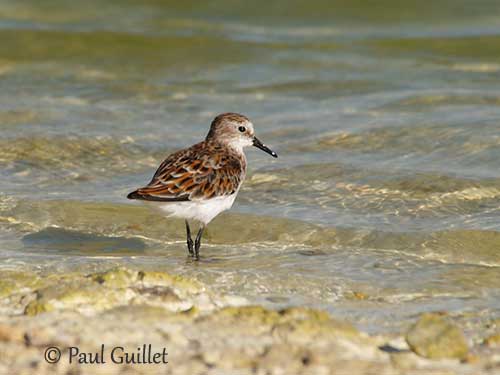
This species is migratory and moves S for wintering in Africa and India. The birds fly in broad front in flocks of 20-30 individuals. They leave the breeding grounds between July and November and move S-SW, and return mid-May/early June.
The flight action is rapid and direct, but the bird may perform sharp twists and turns with rapid wingbeats. It can take-off vertically when flushed.
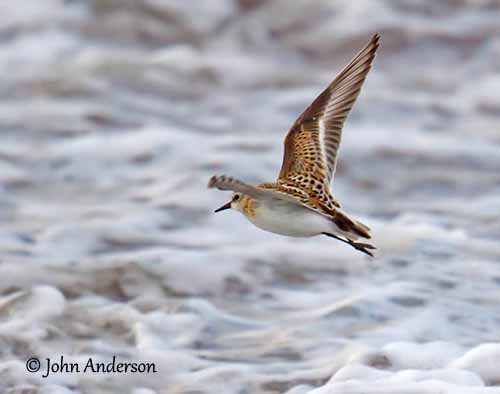
REPRODUCTION OF THIS SPECIES:
The breeding season takes place in spring, with the laying in late June/early July. The Little Stint nests on the ground in dry or grassy areas on the Arctic tundra. The nest is a shallow scrape lined with leaves and grass.
Nest density is about 5 pairs/ha to 10 nests /km², but this estimation varies from year to year.
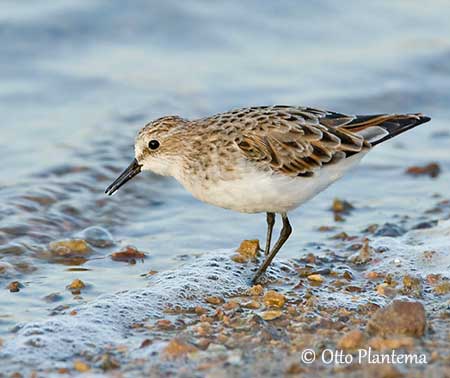
The female lays 3-4 olive-green to yellowish eggs with red-brown spots. Both parents incubate during three weeks, or male and female incubate separate clutches (see above in Behaviour). At hatching, the chicks are orange to chestnut with black and white markings above, and white underparts. The young are able to fly between 15 and 18 days after hatching, and they leave the nest. They start to migrate several days later.
PROTECTION / THREATS / STATUS:
The Little Stint has wide range in which it is not globally threatened, although the species is hunted illegally in India (SE coast) and is affected by degradation of the wintering habitat in Africa.
The global population was estimated at 1,400,000/1,500,000 individuals in 2006.
But currently, the Little Stint is evaluated as Least Concern.
